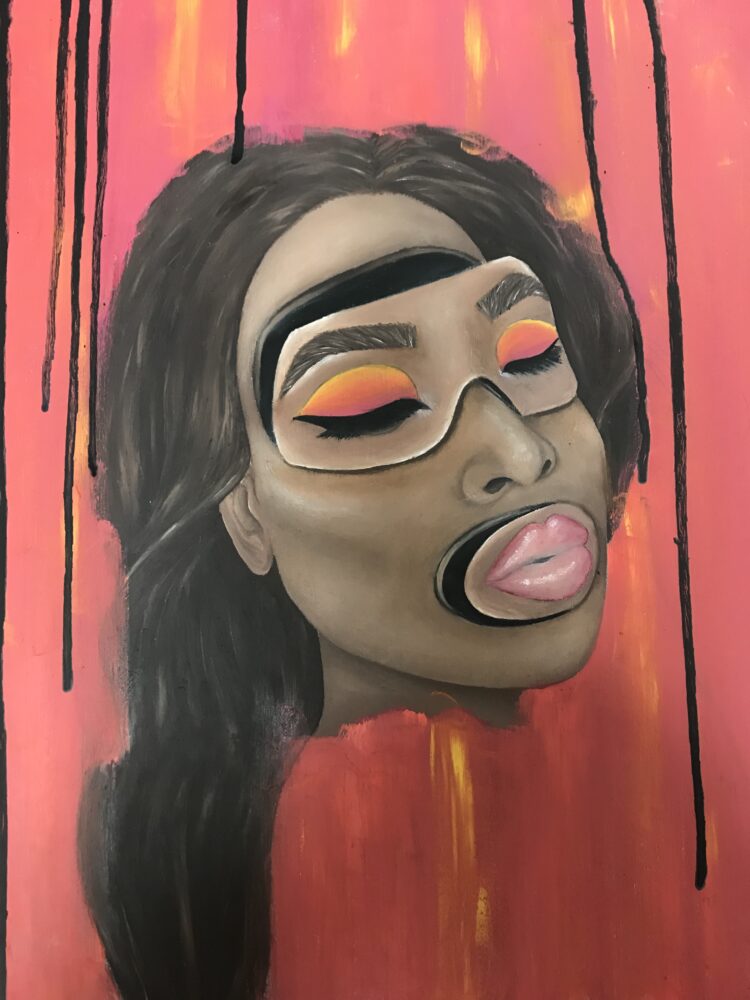Surrealistic art is the expression of the imagination. It is said to balance the rational vision of life with the randomness and unpredictability of unconsciousness and dreams.[1] Surrealism focuses on the emotion that is caused from unconventional beauty. Often times with surrealistic art, you will see realistic facial features, like eyes, with an unexpected twist. This is shown in the image below of a piece named Unveiled Deception that I painted myself. It depicts a person with their skin being peeled back to show a woman with realistic human features. It appeals to unsettling beauty that is shown when traditional boundaries of realistic art are pushed.

The history of surrealism officially began in Paris in 1924, with a writer named André Breton.[2] Breton wrote a surrealist manifesto defining surrealism. Although he was the first artist to officially start surrealism, the movement can be traced back to 1917. During this year, an artist named Giorgio de Chirico founded the scuola metafisica art movement which influenced the beginning of the surrealism movement.[2] An art piece named The Disquieting Muses by Giorgio de Chirico is shown in the image below. It was also found that the word surrealist was coined for a play in 1917 by Guillaume Apollinaire, a French avant-garde poet.[1]

Since surrealism is such a broad category, there are many artists that contributed to the growth of the aesthetic in drastically different ways. Jean Arp, a French artist, often did sculptures that were biomorphic.[3] These sculptures are suggestive but leave room for the inner imagination to interpret. A more well known Belgian artist is René Magritte, who painted pieces of ordinary objects in unexpected context. Often raising questions about the boundaries of art and reality.[3] Shown in the image below is a an art piece by Salvador Dalí named The Persistence of Memory. The melting clock has become quite famous over time.

Many different techniques were used in surrealistic art to invoke psychic emotions. Among these techniques is automatism. This means that they are creating art by accessing material from the unconscious mind.[4] Automatic drawing was often done where one artist would draw a part of the human body and then fold the paper, so it can not be seen, and then hand it to the next artist to add the torso, and so on.[3] Examples of automatic drawing are shown in the two images below. Artists also used techniques like frottage, where they rubbed graphite over wood, and grattage, where they would scrape the canvas. Both these techniques aimed to produce partial images that can then be uniquely finished by the viewer.[3]


I chose surrealism because I have done a bunch of paintings that have fit this aesthetic. Before this I had never really researched surrealism and learned the history behind it. I enjoy the idea of art that is beautiful but also unconventional. I think when imagination is mixed with reality, it invokes emotions that people might not normally get in their day to day lives. I believe when artists are given the freedom to make whatever they want no matter if it pushes the boundaries of traditional beauty, that’s when we get to see their best work. Below are a few more art pieces that I have done in this style. The title of the first painting is The Devil’s Elegance. The title of the second is Fragmented Visions. The title of the final painting is In the Shadow of Anger.



Citations:
Images:
[2] Giorgio de Chirico. Chirico, G. (1916, 1917, or 1918). The Disquieting Muses. Wikipedia https://en.wikipedia.org/wiki/The_Disquieting_Muses
[3] Salvador Dalí. Dalí, S. (1931).The Persistence of Memory. MoMA https://www.moma.org/collection/works/79018
[4] André Masson. Masson, A. (1924). Automatic Drawing. Wikipedia https://en.wikipedia.org/wiki/Surrealist_automatism
[5] Salvador Dalí. Dalí, S. (1927). Automatic Drawing. Widewalls https://www.widewalls.ch/magazine/automatic-drawing/joan-miro-1
Blog:
[1] Tate. (n.d.). Surrealism. https://www.tate.org.uk/art/art-terms/s/surrealism
[2] History.com Editors. (2018, August 21). Surrealism history – art, Definition & Photography. History.com. https://www.history.com/topics/art-history/surrealism-history
[3] The Editors of Encyclopædia Britannica. (2024, January 4). Surrealism. Encyclopædia Britannica. https://www.britannica.com/art/Surrealism
[4] Tate. (n.d.-a). Automatism. https://www.tate.org.uk/art/art-terms/a/automatism


5 Comments. Leave new
[…] Surrealism Aesthetic: https://www.aesdes.org/2024/01/24/aesthetic-exploration-surrealism/ […]
[…] Surrealism Aesthetic: https://www.aesdes.org/2024/01/24/aesthetic-exploration-surrealism/ […]
[…] An aesthetic that I have always found interest in is surrealism. I have been painting for years and I find that surrealism is my style because it allows for me to showcase my realism talent while adding my own creative twist. You can read a bit more about surrealism on my Aesthetics Exploration post: https://www.aesdes.org/2024/01/24/aesthetic-exploration-surrealism/ […]
Sierra, really great post. You’ve covered a lot of ground here and I think it speaks to the amount of research you did. In particular, I appreciate that you dug deeper than just the required historical information and talked about specific techniques employed by surrealist artists. I was also happy to hear something about your own take on surrealism as an aesthetic, and to see your own works in this space, which I think are all spectacular. I do think I’d have liked to hear a bit more about René Magritte’s work, as the description you’ve given doesn’t give much of a sense of the visual style and what sets it apart from other surrealist work. Overall, really good work.
Hey Sierra, your exploration of surrealism is truly fascinating, especially with your painting, “Unveiled Deception,” where you seamlessly blend realistic features with an unexpected twist. Learning about the history, from André Breton to René Magritte, adds depth to my understanding of this diverse art movement. I resonate with your perspective on the beauty of unconventional art and appreciate how you’ve applied surrealism in your own pieces like “The Devil’s Elegance” and “In the Shadow of Anger.”